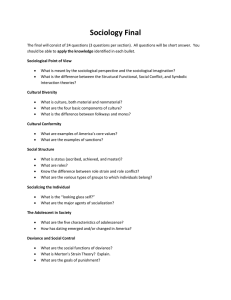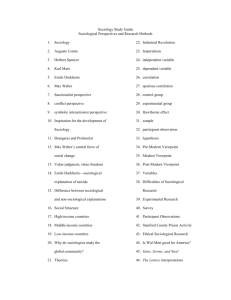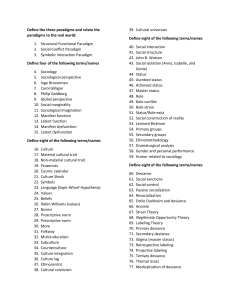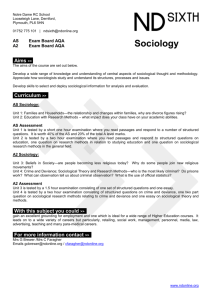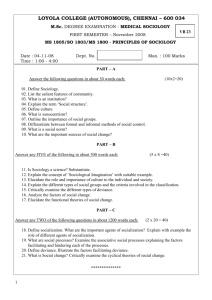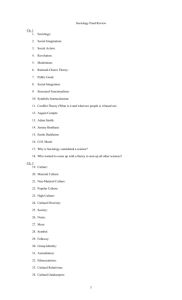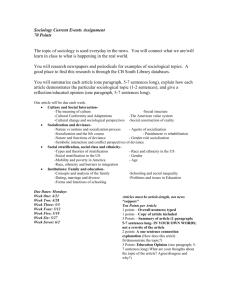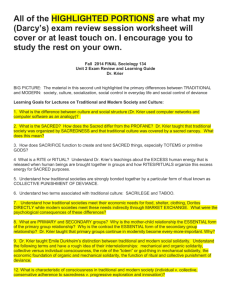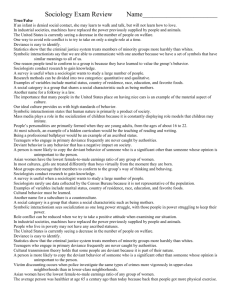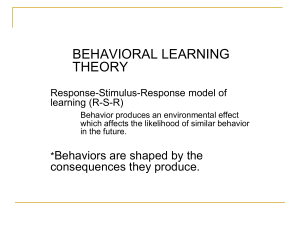File - Mr. Miller's Online Classroom
advertisement
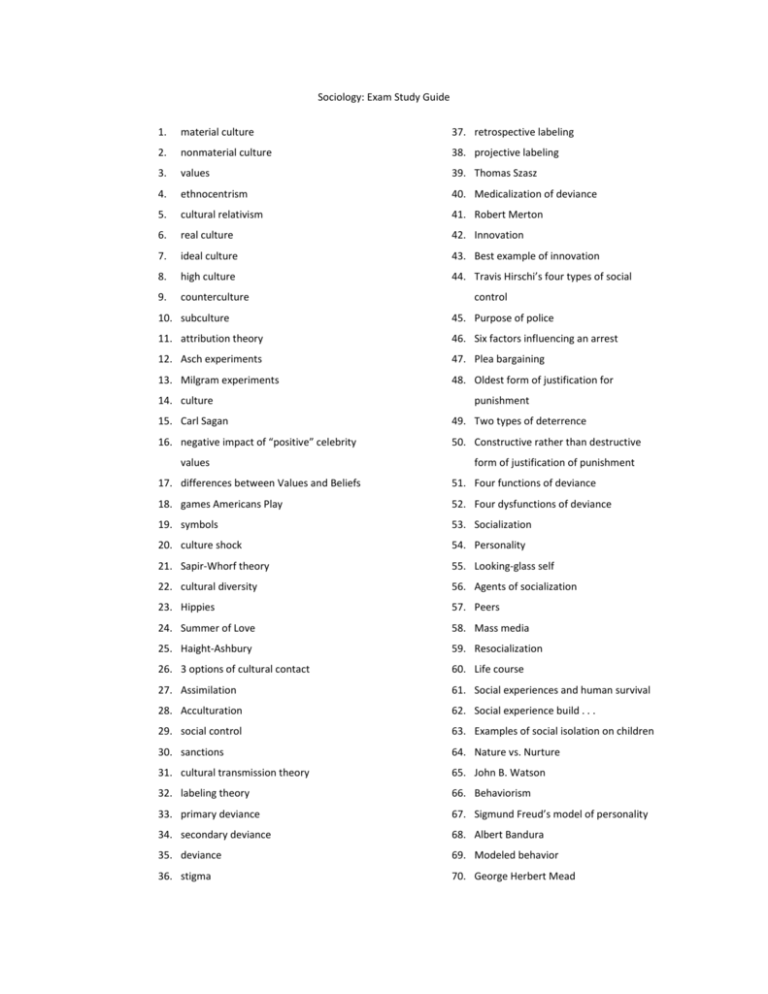
Sociology: Exam Study Guide 1. material culture 37. retrospective labeling 2. nonmaterial culture 38. projective labeling 3. values 39. Thomas Szasz 4. ethnocentrism 40. Medicalization of deviance 5. cultural relativism 41. Robert Merton 6. real culture 42. Innovation 7. ideal culture 43. Best example of innovation 8. high culture 44. Travis Hirschi’s four types of social 9. counterculture control 10. subculture 45. Purpose of police 11. attribution theory 46. Six factors influencing an arrest 12. Asch experiments 47. Plea bargaining 13. Milgram experiments 48. Oldest form of justification for 14. culture punishment 15. Carl Sagan 49. Two types of deterrence 16. negative impact of “positive” celebrity 50. Constructive rather than destructive values form of justification of punishment 17. differences between Values and Beliefs 51. Four functions of deviance 18. games Americans Play 52. Four dysfunctions of deviance 19. symbols 53. Socialization 20. culture shock 54. Personality 21. Sapir-Whorf theory 55. Looking-glass self 22. cultural diversity 56. Agents of socialization 23. Hippies 57. Peers 24. Summer of Love 58. Mass media 25. Haight-Ashbury 59. Resocialization 26. 3 options of cultural contact 60. Life course 27. Assimilation 61. Social experiences and human survival 28. Acculturation 62. Social experience build . . . 29. social control 63. Examples of social isolation on children 30. sanctions 64. Nature vs. Nurture 31. cultural transmission theory 65. John B. Watson 32. labeling theory 66. Behaviorism 33. primary deviance 67. Sigmund Freud’s model of personality 34. secondary deviance 68. Albert Bandura 35. deviance 69. Modeled behavior 36. stigma 70. George Herbert Mead 71. Agents of Socialization 106. Social Structure 72. Family 107. What is at the heart of society? 73. School 108. High-income countries 74. Peers 109. Middle-income countries 75. Mass Media 110. Low-income countries 76. Teachings of parents according to SES 111. Why do sociologists study the global 77. The “hidden curriculum” community? 78. Appeal of the peer group 112. Industrial Revolution 79. Anticipatory socialization 113. Imperialism 80. “hurried child” syndrome 114. independent variable 81. Life course stages 115. dependent variable 82. Childhood 116. correlation 83. Adolescence 117. spurious correlation 84. Young Adulthood 118. control group 85. Middle Adulthood 119. experimental group 86. Old Age 120. Hawthorne effect 87. Death 121. sample 88. Children’s toys and gender roles 122. participant observation 89. Five stages of death 123. hypothesis 90. Sex and Gender 124. Pre-Modern Viewpoint 91. Auguste Comte 125. Modern Viewpoint 92. Herbert Spencer 126. Post-Modern Viewpoint 93. Karl Marx 127. Variables 94. Emile Durkheim 128. Difficulties of Sociological Research 95. Max Weber 129. Experimental Research 96. functionalist perspective 130. Survey 97. conflict perspective 131. Participant Observations 98. inteactionist perspective 132. Stanford County Prison Activity 99. Sociological perspective stresses . . . 133. Ethical Sociological Research 100. Inspiration for the development of 134. Guns, Germs, and Steel Sociology 101. Bourgeois and Proletariat 102. Max Weber’s central force of social change 103. Value-judgment; value-freedom 104. Emile Durkheim—sociological explanation of suicide 105. Difference between sociological and non-sociological explanations
